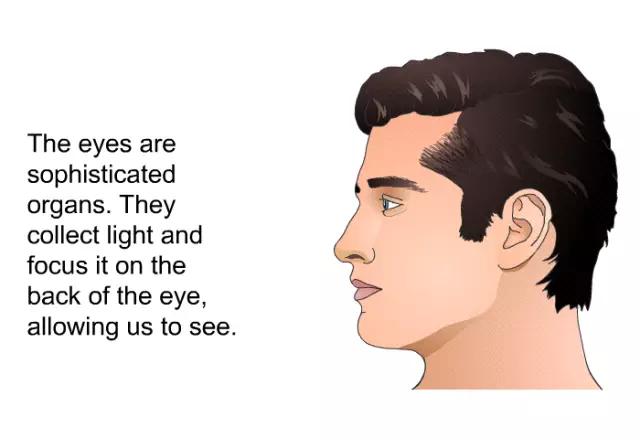- Author Rachel Wainwright [email protected].
- Public 2023-12-15 07:39.
- Last modified 2025-11-02 20:14.
6 indicative eye changes
Poets call human eyes the mirror of the soul. But not only this is true: the condition of the eyes directly depends on how correctly the body as a whole functions. Our story is about those changes that may indicate health problems.
Protein yellow
Changes in the color of the sclera, as a rule, are associated with malfunctions in the liver or gallbladder. One of the most important functions of the liver is to cleanse the blood from bilirubin, a reddish-brown pigment formed when hemoglobin is destroyed. The body of a healthy person produces acids that bind bilirubin and render it inactive. The pigment, neutralized in this way, subsequently becomes one of the main components of bile and is excreted from the body together with it.
If this process is abnormal, bilirubin remains in the blood, staining some tissues (including the whites of the eyes) yellow. Changes of this kind are typical for hepatitis, obstruction of the bile duct, leptospirosis, cirrhosis or liver cancer, as well as for diseases associated with liver damage by parasitic organisms (echinococcosis, opisthorchiasis, etc.). Icterus (yellowing) of the sclera can be observed in inflammatory diseases of the biliary tract or pathologies characterized by too intense destruction of red blood cells (for example, malaria). These symptoms also occur against the background of intoxication:
- alcohol;
- poisons of biological origin (bee, snake, spider venom or toxic substances contained in mushrooms or berries);
- so-called hemolytic poisons, which include, in particular, benzene, arsenic, chloroform, copper compounds, nitrates.
Slight yellowing of the sclera can be caused by poor diet and chronic lack of sleep. In the absence of pathology, this condition goes away on its own. You just need to establish the correct sleep and wakefulness regimen, spend more time in the fresh air and temporarily remove smoked, fried, salty and spicy foods from the diet.

Source: ladyspecial.ru
Frequent barley
Barley is an inflammation of the sebaceous gland located at the edge of the eyelid, next to the hair follicles from which eyelashes grow. Probably everyone has faced such troubles. If a person does not have special health problems, he rarely suffers from barley, and the inflammation disappears without a trace within a few days.
Too frequent appearance of barley may indicate a serious metabolic disorder or a weakening of the body's defenses. If the inflammation becomes chronic, one must bear in mind the possibility of developing a tumor of the sebaceous gland.

Source: depositphotos.com
Blurred image
The most common cause of blurred vision is the so-called dry eye syndrome. Pathology occurs with chronic eye fatigue. Before the advent of personal computers, tablets and other modern gadgets, it mainly affected people doing small jobs (hand embroidery, assembling miniature parts, etc.). Now the disease is often diagnosed not only in adults who spend working hours in front of monitors, but also in a significant number of children and adolescents.
Patients with diabetes mellitus often have a complication associated with a violation of the walls of blood vessels that penetrate the retina (diabetic retinopathy). It is characterized by the appearance of cloudy spots before the eyes.
The fuzziness of the entire image is a symptom of the initial stages of cataract (lens opacity).

Source: depositphotos.com
Loss of eyebrows
Having noticed that the hairs of the eyebrows become thinner or actively fall out, a person is usually inclined to consider this a minor cosmetic defect. In fact, the process may indicate serious health problems. The condition of the eyebrows is affected by fluctuations in the hormonal background. In particular, hair falls out, becomes thin and brittle with hypothyroidism - a lack of thyroid hormones.
If a problem of this kind is found, it is worth visiting not only a trichologist, but also an endocrinologist.

Source: elia-chaba.com
Bulging eyes
Normally, the whites of the eyes should be visible on both sides of the iris, but not above or below it. Sometimes a slight bulging of the eyes is a hereditary feature of members of the same family, but in most cases, these changes indicate the presence of serious disorders in the body.
Bulging (exophthalmos), as a rule, is observed:
- with hyperthyroidism (excess secretion of thyroid hormones). The symptom manifests itself in people suffering from Graves' disease, as well as some pathologies of the pituitary gland and hypothalamus;
- with glaucoma;
- with hemangiomas;
- with leukemia;
- with neuroblastomas;
- with orbital cellulite (infectious lesion of the soft tissues of the muscular apparatus of the eye);
- with malignant neoplasms of the tissues of the eye orbits.
If you notice a protrusion of one or both eyeballs, an urgent need to consult a doctor.

Source: depositphotos.com
Blind spots in sight
The appearance in the field of vision of areas of image loss or areas of reduced color perception is most often associated with eye diseases (cataract, glaucoma, degenerative lesions of the retina, etc.) or with improper functioning of the blood vessels of the brain. Usually, the symptom is observed simultaneously with periodic headaches, nausea and a general decrease in visual acuity. Often, patients complain about the appearance of intrusive light effects ("flies", "lightning" or colored spots in front of the eyes).
Symptoms of this kind may indicate a serious health problem and require immediate diagnosis. It is especially dangerous to ignore instant blurred vision or complete blackout, since such effects are often associated with large-scale disorders of cerebral circulation (strokes).
Mood, performance and social realization of a person largely depend on eye health. Any deterioration in vision entails a decline in living standards. But that's not all: even a subtle change in the state of the organs of vision can indicate the onset of serious ailments, therefore, each such change must be monitored. An attentive and serious attitude to the condition of the eyes will not only help to avoid specific ophthalmic diseases, but also allow you to notice other health problems in time.
YouTube video related to the article:

Maria Kulkes Medical journalist About the author
Education: First Moscow State Medical University named after I. M. Sechenov, specialty "General Medicine".
Found a mistake in the text? Select it and press Ctrl + Enter.






